Guten tag! The theme of Cinefest, the 17th International Festival of German Film-Heritage is 'German-Dutch Film Relations'. A German film with a Dutch touch is Es/It (Ulrich Schamoni, 1964) shot by cinematographer Gérard Vandenberg from the Netherlands. Star of Es is the German stage and film actress Sabine Sinjen (1942-1995), who won the Filmband in Gold, the German equivalent of the Oscar, for her role. In the 1950s, Sinjen had started as a natural and innocent teenager star, but she changed her image and became one of the protagonists of the Neue Deutsche Film in the 1960s and also a respected stage actress.
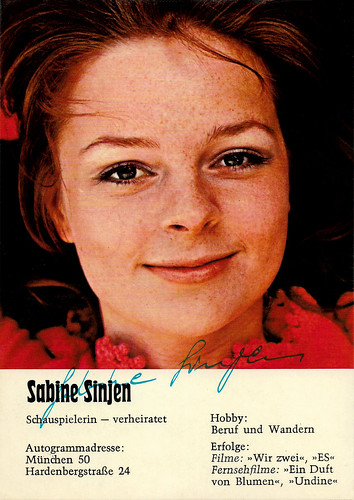
German recipe card by Axel Juncker Verlag GmbH, München / Zürich / Wien. On the flip side a recipe for Crabs in dill sauce with saffron rice and cucumber salad.
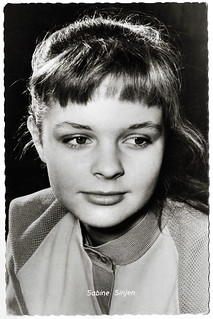
German postcard by Kolibri-Verlag G.m.b.H., Minden/Westf., no. 957. Photo: Kolibri / Otfried / Schmidt.

German postcard by Kolibri-Verlag G.m.b.H., Minden-Westf., no. 569. Photo: Kolibri / Enzwieser.

German postcard by Kolibri-Verlag G.m.b.H., Minden-Westf., no. 615. Photo: Kolibri / Enzwieser.

German postcard by Kolibri-Verlag G.m.b.H., Minden/Westf., no. 737. Photo: Kolibri / Lothar Winkler.

German postcard by Kolibri Verlag G.m.b.H., Minden/Westf., no. 773. Photo: Kolibri / Entwieser.
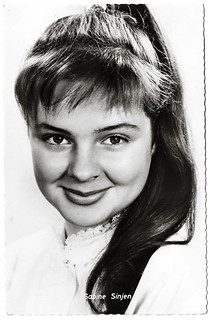
German postcard by Kolibri-Verlag G.m.b.H., Minden/Westf., no. 847. Photo: Kolibri / Studio Meinen, München (Munich).

Dutch postcard by Gebr. Spanjersberg N.V., Rotterdam, no. 4295, licency holder for UFA/Film-Foto in the Netherlands. Sent by mail in 1959. Photo: UFA.
Sabine Sinjen was born in Itzehoe, Germany, in 1942 as the daughter of the journalist Marlen Sinjen, born Kolbe. Her father, an engineer and architect, died during World War II in Russia.
Together with her mother and older sisters Julia and Frauke, she grew up in Hamburg and Munich. As a little girl, she already performed for the children's radio of the WDR. Later she took drama lessons.
In Die Frühreifen/Precocious Youth (Josef von Báky, 1957) she played her first film role as the innocent-naive Hannelore who falls in love with the wrong guy. In the cast were also such popular teen stars as Heidi Brühl and Peter Kraus.
She proved to be a natural talent and next, she played with Lili Palmer and Romy Schneider in the remake of Mädchen in Uniform/Girls in Uniform (Géza von Radványi, 1958).
Producer Artur Brauner gave her a seven-year contract, and she became a star with the box office hit Stefanie (Josef von Báky, 1958) opposite Carlos Thompson and the sequel Stefanie in Rio (Curtis Bernhardt, 1960). She also appeared in Das Glas Wasser/A Glass of Water (Helmut Käutner, 1960) next to Gustaf Gründgens and Lilo Pulver.
Brauner kept her playing the natural and innocent teenager in cheesy Heimatfilms like Die Försterchristel/The Forester's Daughter (Franz Josef Gottlieb, 1962), but she did not want to be typecasted and broke her contract.
Like Romy Schneider, she went to France, where she made films like Les tontons flingueurs/Crooks in Clover (Georges Lautner, 1963), starring Lino Ventura and Bernard Blier. She also appeared in the EuroWestern Die Flußpiraten vom Mississippi/The Pirates of the Mississippi (Jürgen Roland, 1964) opposite Hansjörg Felmy and Brad Harris. It was a co-production between West Germany, France, and Italy.

Dutch postcard by Hercules, Haarlem, no. 279. Photo: Hafbofilm. Sabine Sinjen and Corny Collins in Schmutziger Engel/Imperfect Angel (Alfred Vohrer, 1958).

German postcard by Ufa. Photo: Publicity still for Stefanie (1958) with Carlos Thompson.
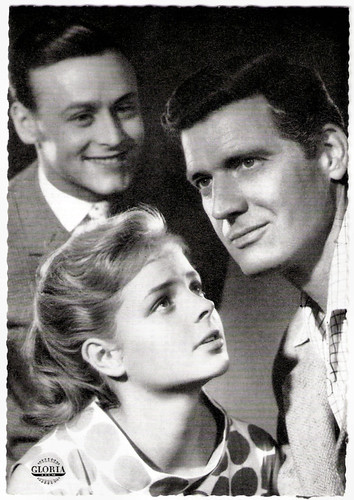
German postcard by Filmbilder-Vertrieb Ernst Freihoff, Essen. Photo: CCC-Film / Gloria-Film / Arthur Grimm. Paul Hubschmid, Sabine Sinjen and Helmut Lohner in Marili (Josef von Báky, 1959).
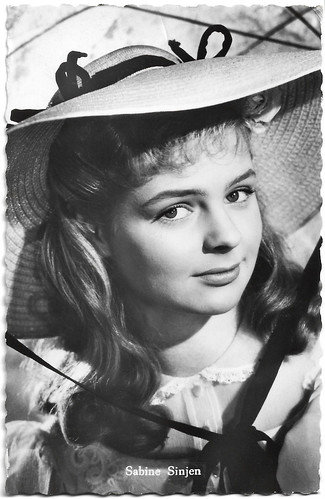
Dutch postcard by N.V. v.h. Weenenk & Snel, Baarn, no. 306. Sabine Sinjen in Alt Heidelberg/Old Heidelberg (Ernst Marischka, 1959). Collection: Geoffrey Donaldson Institute.
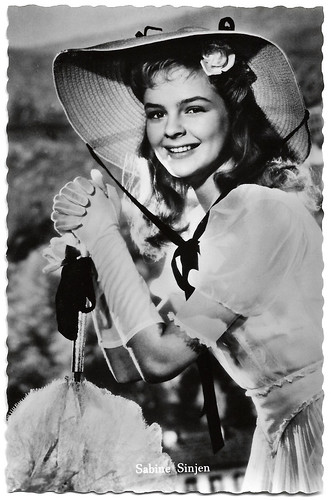
Dutch postcard, no. 1060. Sabine Sinjen in Alt Heidelberg/Old Heidelberg (Ernst Marischka, 1959). Collection: Geoffrey Donaldson Institute.
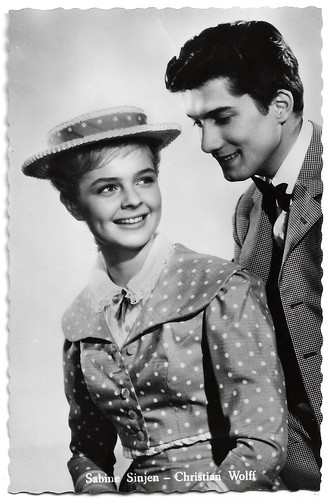
Dutch postcard by N.V. v.h. Weenenk & Snel, Baarn, no. 1066. Sabine Sinjen and Christian Wolff in Alt Heidelberg/Old Heidelberg (Ernst Marischka, 1959). Collection: Geoffrey Donaldson Institute.

Dutch postcard by Gebr. Spanjersberg N.V., Rotterdam, no. 1312. Photo: Ufa. Sabine Sinjen and Peter Kraus in Kein Engel ist so rein/No angel is so pure (Wolfgang Becker, 1960).
In the early 1960s, Sabine Sinjen debuted as a stage actress as Wendla Bergmann in Frank Wedekind's play 'Frühlings Erwachen' (Spring Awakening) at the Schillertheater in Berlin. She stayed at the Schillertheater for two years. Later she performed at the Staatlichen Schauspielbühnen Berlin (1967) and at the Theater in der Josefstadt (1967-1971) in Vienna.
On TV, she became very popular as the daughter of veterinarian Gustav Knuth and Tilly Lauenstein in the family series Alle meine Tiere/All My Animals (1962-1963). She also appeared with Martin Benrath and Gerlinde Locker on television in the Oscar Wilde comedy Ein idealer Gatte/Am Ideal Husband (1965)
In 1963 Sinjen married director Peter Beauvais, with whom she made some ambitious literary adaptations for television such as Die Ratten/The Rats (Peter Beauvais, 1969), based on a play by Gerhart Hauptmann, and Dorothea Merz (Peter Beauvais, 1976) based on the novel by Tankred Dorst. She also appeared in several entertainment productions, such as the Courths-Mahler adaptation Griseldis (Peter Beauvais, 1974), which moved millions of viewers to tears.
In the mid-1960s she started to work with film director Ulrich Schamoni and became the protagonist of the Neue Deutsche Film (New German Cinema). Es/It (Ulrich Schamoni, 1965) tells the story of a young couple and the marriage crisis resulting from a concealed pregnancy and abortion. For her role, Sinjen won the Filmband in Gold, the German Oscar, for her role.
Next, she played women in problematic situations in such films as Alle Jahre wieder/Next Year, Same Time (Ulrich Schamoni, 1967), and Wir zwei/We Two (Ulrich Schamoni, 1969).

German postcard by WS-Druck, Wanne-Eickel, no. 291. Photo: Arthur Grimm / Europa.

Dutch postcard by Takken, Utrecht, no. AX 4566.

Dutch postcard by Takken, Utrecht, no. AX 4199. Photo: HAFBO-Film.

Dutch postcard by Gebr. Spanjersberg N.V.(Licency holder of Ufa/Film-Foto for the Netherlands), Rotterdam, no. 1281. Photo: Ufa.
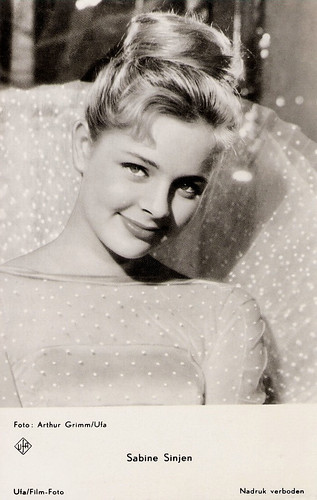
Dutch postcard by Gebr. Spanjersberg N.V. (Licency holder of Ufa/Film-Foto for the Netherlands), Rotterdam, no. 358/960. Photo: Arthur Grimm / Ufa.

East-German postcard by VEB Progress Film-Vertrieb, Berlin, no. 1755, 1962. Sabine Sinjen and Helmut Lohner in Im sechsten Stock (John Olden, 1961).

Dutch postcard by SYBA, no. 461. Promotional card for Centrafilm, Den Haag. Publicity still for Die Försterchristel/The Forester's Daughter (1962) with Peter Weck.

East-German collectors card in the 'Neu im Kino' series by VEB Progress Film-Vertrieb, Berlin, no. 500/6/68. Sabine Sinjen and Hans-Dieter Schwarze in Alle Jahre wieder/Next Year, Same Time (Ulrich Schamoni, 1967).
During the 1970s, Sabine Sinjen concentrated on theatre and television. She dis aguest appearances at the Zürcher Schauspielhaus and from 1976 till 1980, she was a permanent member of the Thalia-Theater in Hamburg.
In 1971, she appeared as one of 28 women under the banner 'We've had abortions!' (Wir haben abgetrieben!) on the cover page of the West German magazine Stern on 6 June 1971. In that issue, 374 women publicly stated that they had had pregnancies terminated, which at that time was illegal.
Occasionally she made a film, like Am Wege/On the Road (Peter Beauvais, 1975) and Caspar David Friedrich - Grenzen der Zeit/Boundaries of Time: Caspar David Friedrich (Peter Schamoni, 1986).
In 1984 she was diagnosed with cancer and lost sight in her right eye, but still, she kept playing in theatre and on TV, wearing an eye-patch. Passionately, she fought against the disease until the last moment. After her serious illness, Sinjen had a much-noticed theatre comeback in 1987 at the Schillertheater in Jean Cocteau's solo play 'Die geliebte Stimme' (The Beloved Voice).
In 1994 - a few months before her death - she had to stop rehearsing for Heiner Müller's 'Quartet' at the theatre in Aachen. Her last film part had been in Das Haus im Ginster/The House in the Macchia (Gottfried Junker, 1992) and her final television appearance was in the TV play Von Frau zu Frau: Die Sammlerin/From woman to woman: the collector (Peter Weck, 1994) with Christiane Hörbiger.
In 1995, Sabine Sinjen died in Berlin, only 52. She was buried at the cemetery in Irrsdorf near Salzburg. Sinjen was married twice, first to Peter Beauvais till 1984 and then till her death to Günther Huber, who was also a director and was the father of her son, Simon.

German postcard by ISV, no. M 19. Photo: Europa Film / Lilo.
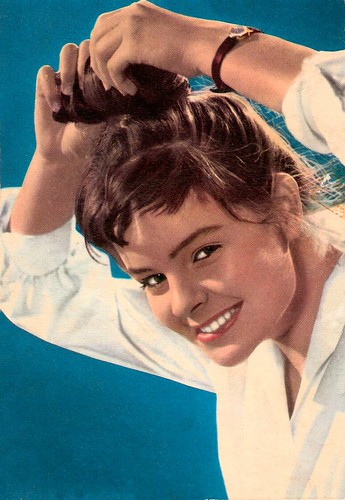
German postcard by ISV, no. M 20. Photo: Europa Film / Lilo.
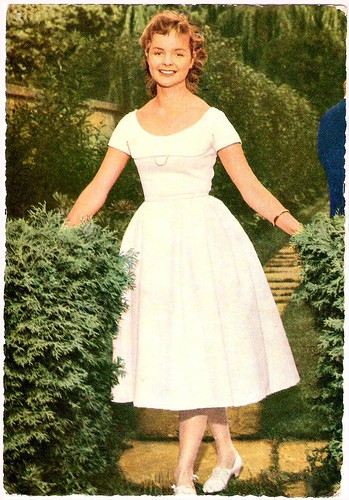
German postcard by Terra-Color, no. F 150. Photo: private.
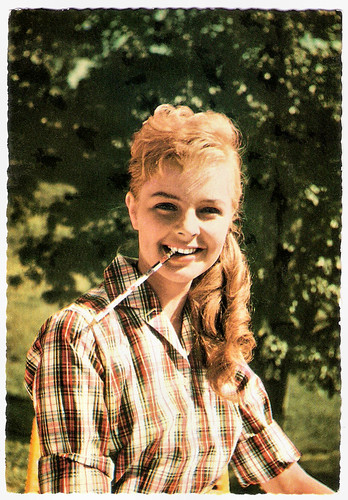
German postcard by Terra-Color, no. F 183.
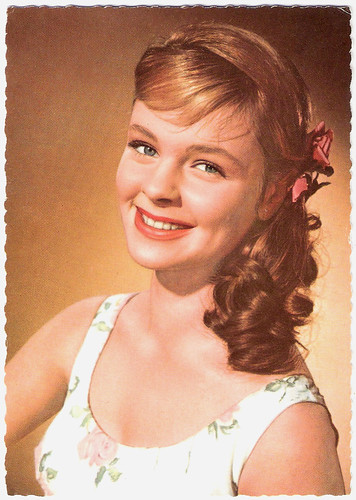
German postcard by UFA, Berlin-Tempelhoff, no. CK-207. Retail price: 30 Pfg. Photo: UFA.

German postcard by UFA, Berlin-Tempelhoff, no. CK-255. Retail price: 30 Pfg. Photo: Serda / UFA.

German postcard by UFA, Berlin-Tempelhoff, no. CK-316. Retail price: 30 Pfg. Photo: Arthur Grimm / UFA.

German postcard by UFA, Berlin-Tempelhof, no. CK-343. Photo: Klaus Collignon.
Sources: Stephanie D'heil (Steffi-Line), Filmportal.de (German), Wikipedia (German), and IMDb.

German recipe card by Axel Juncker Verlag GmbH, München / Zürich / Wien. On the flip side a recipe for Crabs in dill sauce with saffron rice and cucumber salad.

German postcard by Kolibri-Verlag G.m.b.H., Minden/Westf., no. 957. Photo: Kolibri / Otfried / Schmidt.

German postcard by Kolibri-Verlag G.m.b.H., Minden-Westf., no. 569. Photo: Kolibri / Enzwieser.

German postcard by Kolibri-Verlag G.m.b.H., Minden-Westf., no. 615. Photo: Kolibri / Enzwieser.

German postcard by Kolibri-Verlag G.m.b.H., Minden/Westf., no. 737. Photo: Kolibri / Lothar Winkler.

German postcard by Kolibri Verlag G.m.b.H., Minden/Westf., no. 773. Photo: Kolibri / Entwieser.

German postcard by Kolibri-Verlag G.m.b.H., Minden/Westf., no. 847. Photo: Kolibri / Studio Meinen, München (Munich).

Dutch postcard by Gebr. Spanjersberg N.V., Rotterdam, no. 4295, licency holder for UFA/Film-Foto in the Netherlands. Sent by mail in 1959. Photo: UFA.
Cheesy Heimatfilms
Sabine Sinjen was born in Itzehoe, Germany, in 1942 as the daughter of the journalist Marlen Sinjen, born Kolbe. Her father, an engineer and architect, died during World War II in Russia.
Together with her mother and older sisters Julia and Frauke, she grew up in Hamburg and Munich. As a little girl, she already performed for the children's radio of the WDR. Later she took drama lessons.
In Die Frühreifen/Precocious Youth (Josef von Báky, 1957) she played her first film role as the innocent-naive Hannelore who falls in love with the wrong guy. In the cast were also such popular teen stars as Heidi Brühl and Peter Kraus.
She proved to be a natural talent and next, she played with Lili Palmer and Romy Schneider in the remake of Mädchen in Uniform/Girls in Uniform (Géza von Radványi, 1958).
Producer Artur Brauner gave her a seven-year contract, and she became a star with the box office hit Stefanie (Josef von Báky, 1958) opposite Carlos Thompson and the sequel Stefanie in Rio (Curtis Bernhardt, 1960). She also appeared in Das Glas Wasser/A Glass of Water (Helmut Käutner, 1960) next to Gustaf Gründgens and Lilo Pulver.
Brauner kept her playing the natural and innocent teenager in cheesy Heimatfilms like Die Försterchristel/The Forester's Daughter (Franz Josef Gottlieb, 1962), but she did not want to be typecasted and broke her contract.
Like Romy Schneider, she went to France, where she made films like Les tontons flingueurs/Crooks in Clover (Georges Lautner, 1963), starring Lino Ventura and Bernard Blier. She also appeared in the EuroWestern Die Flußpiraten vom Mississippi/The Pirates of the Mississippi (Jürgen Roland, 1964) opposite Hansjörg Felmy and Brad Harris. It was a co-production between West Germany, France, and Italy.

Dutch postcard by Hercules, Haarlem, no. 279. Photo: Hafbofilm. Sabine Sinjen and Corny Collins in Schmutziger Engel/Imperfect Angel (Alfred Vohrer, 1958).

German postcard by Ufa. Photo: Publicity still for Stefanie (1958) with Carlos Thompson.

German postcard by Filmbilder-Vertrieb Ernst Freihoff, Essen. Photo: CCC-Film / Gloria-Film / Arthur Grimm. Paul Hubschmid, Sabine Sinjen and Helmut Lohner in Marili (Josef von Báky, 1959).

Dutch postcard by N.V. v.h. Weenenk & Snel, Baarn, no. 306. Sabine Sinjen in Alt Heidelberg/Old Heidelberg (Ernst Marischka, 1959). Collection: Geoffrey Donaldson Institute.

Dutch postcard, no. 1060. Sabine Sinjen in Alt Heidelberg/Old Heidelberg (Ernst Marischka, 1959). Collection: Geoffrey Donaldson Institute.

Dutch postcard by N.V. v.h. Weenenk & Snel, Baarn, no. 1066. Sabine Sinjen and Christian Wolff in Alt Heidelberg/Old Heidelberg (Ernst Marischka, 1959). Collection: Geoffrey Donaldson Institute.

Dutch postcard by Gebr. Spanjersberg N.V., Rotterdam, no. 1312. Photo: Ufa. Sabine Sinjen and Peter Kraus in Kein Engel ist so rein/No angel is so pure (Wolfgang Becker, 1960).
Neue Deutsche film
In the early 1960s, Sabine Sinjen debuted as a stage actress as Wendla Bergmann in Frank Wedekind's play 'Frühlings Erwachen' (Spring Awakening) at the Schillertheater in Berlin. She stayed at the Schillertheater for two years. Later she performed at the Staatlichen Schauspielbühnen Berlin (1967) and at the Theater in der Josefstadt (1967-1971) in Vienna.
On TV, she became very popular as the daughter of veterinarian Gustav Knuth and Tilly Lauenstein in the family series Alle meine Tiere/All My Animals (1962-1963). She also appeared with Martin Benrath and Gerlinde Locker on television in the Oscar Wilde comedy Ein idealer Gatte/Am Ideal Husband (1965)
In 1963 Sinjen married director Peter Beauvais, with whom she made some ambitious literary adaptations for television such as Die Ratten/The Rats (Peter Beauvais, 1969), based on a play by Gerhart Hauptmann, and Dorothea Merz (Peter Beauvais, 1976) based on the novel by Tankred Dorst. She also appeared in several entertainment productions, such as the Courths-Mahler adaptation Griseldis (Peter Beauvais, 1974), which moved millions of viewers to tears.
In the mid-1960s she started to work with film director Ulrich Schamoni and became the protagonist of the Neue Deutsche Film (New German Cinema). Es/It (Ulrich Schamoni, 1965) tells the story of a young couple and the marriage crisis resulting from a concealed pregnancy and abortion. For her role, Sinjen won the Filmband in Gold, the German Oscar, for her role.
Next, she played women in problematic situations in such films as Alle Jahre wieder/Next Year, Same Time (Ulrich Schamoni, 1967), and Wir zwei/We Two (Ulrich Schamoni, 1969).

German postcard by WS-Druck, Wanne-Eickel, no. 291. Photo: Arthur Grimm / Europa.

Dutch postcard by Takken, Utrecht, no. AX 4566.

Dutch postcard by Takken, Utrecht, no. AX 4199. Photo: HAFBO-Film.

Dutch postcard by Gebr. Spanjersberg N.V.(Licency holder of Ufa/Film-Foto for the Netherlands), Rotterdam, no. 1281. Photo: Ufa.

Dutch postcard by Gebr. Spanjersberg N.V. (Licency holder of Ufa/Film-Foto for the Netherlands), Rotterdam, no. 358/960. Photo: Arthur Grimm / Ufa.

East-German postcard by VEB Progress Film-Vertrieb, Berlin, no. 1755, 1962. Sabine Sinjen and Helmut Lohner in Im sechsten Stock (John Olden, 1961).

Dutch postcard by SYBA, no. 461. Promotional card for Centrafilm, Den Haag. Publicity still for Die Försterchristel/The Forester's Daughter (1962) with Peter Weck.

East-German collectors card in the 'Neu im Kino' series by VEB Progress Film-Vertrieb, Berlin, no. 500/6/68. Sabine Sinjen and Hans-Dieter Schwarze in Alle Jahre wieder/Next Year, Same Time (Ulrich Schamoni, 1967).
We've had abortions!
During the 1970s, Sabine Sinjen concentrated on theatre and television. She dis aguest appearances at the Zürcher Schauspielhaus and from 1976 till 1980, she was a permanent member of the Thalia-Theater in Hamburg.
In 1971, she appeared as one of 28 women under the banner 'We've had abortions!' (Wir haben abgetrieben!) on the cover page of the West German magazine Stern on 6 June 1971. In that issue, 374 women publicly stated that they had had pregnancies terminated, which at that time was illegal.
Occasionally she made a film, like Am Wege/On the Road (Peter Beauvais, 1975) and Caspar David Friedrich - Grenzen der Zeit/Boundaries of Time: Caspar David Friedrich (Peter Schamoni, 1986).
In 1984 she was diagnosed with cancer and lost sight in her right eye, but still, she kept playing in theatre and on TV, wearing an eye-patch. Passionately, she fought against the disease until the last moment. After her serious illness, Sinjen had a much-noticed theatre comeback in 1987 at the Schillertheater in Jean Cocteau's solo play 'Die geliebte Stimme' (The Beloved Voice).
In 1994 - a few months before her death - she had to stop rehearsing for Heiner Müller's 'Quartet' at the theatre in Aachen. Her last film part had been in Das Haus im Ginster/The House in the Macchia (Gottfried Junker, 1992) and her final television appearance was in the TV play Von Frau zu Frau: Die Sammlerin/From woman to woman: the collector (Peter Weck, 1994) with Christiane Hörbiger.
In 1995, Sabine Sinjen died in Berlin, only 52. She was buried at the cemetery in Irrsdorf near Salzburg. Sinjen was married twice, first to Peter Beauvais till 1984 and then till her death to Günther Huber, who was also a director and was the father of her son, Simon.

German postcard by ISV, no. M 19. Photo: Europa Film / Lilo.

German postcard by ISV, no. M 20. Photo: Europa Film / Lilo.

German postcard by Terra-Color, no. F 150. Photo: private.

German postcard by Terra-Color, no. F 183.

German postcard by UFA, Berlin-Tempelhoff, no. CK-207. Retail price: 30 Pfg. Photo: UFA.

German postcard by UFA, Berlin-Tempelhoff, no. CK-255. Retail price: 30 Pfg. Photo: Serda / UFA.

German postcard by UFA, Berlin-Tempelhoff, no. CK-316. Retail price: 30 Pfg. Photo: Arthur Grimm / UFA.

German postcard by UFA, Berlin-Tempelhof, no. CK-343. Photo: Klaus Collignon.
Sources: Stephanie D'heil (Steffi-Line), Filmportal.de (German), Wikipedia (German), and IMDb.
After publishing this post, we got a request to post the recipe of the upper postcard too. At your service!

German recipe card by Axel Juncker Verlag GmbH, München / Zürich / Wien.
And here is the translation of the recipe:
Crabs in Dill sauce with Saffron rice and Cucumber salad
This is needed
1/2 pound North Sea crabs
1 Teaspoon butter
1 Teaspoon flour
1 Cup of milk
Dill tips
Some vinegar
Salt, Pepper
1 Cup of rice
1 1/2 Cups of saffron broth
50 g Fat
How to do it
Crabs in Dill sauce
Lightly sweat the flour with butter. Pour in the milk and stir. Add dill and a little vinegar, stir until cooked. Pass through. Add the finely chopped dill tips, season with salt and pepper. Heat the crabs and serve in the sauce.
Rice
Dissolve the saffron in the fat. add rice and broth. Steam for about 10 minutes. Serve with the dill sauce.
Cucumber salad is served with it.
Sabine Sinjen was a German film actress. She appeared in 54 films between 1957 and 1994.She has got natural beauty.
ReplyDeleteBrauner kept her playing the natural and innocent teenager in cheesy Heimatfilms like Die Försterchristel/The Forester's Daughter (1962, Franz Josef Gottlieb), but she did not want to be typecasted and broke her contract.
ReplyDelete